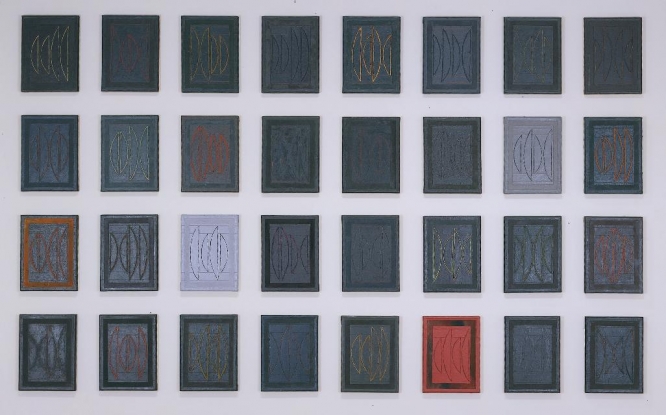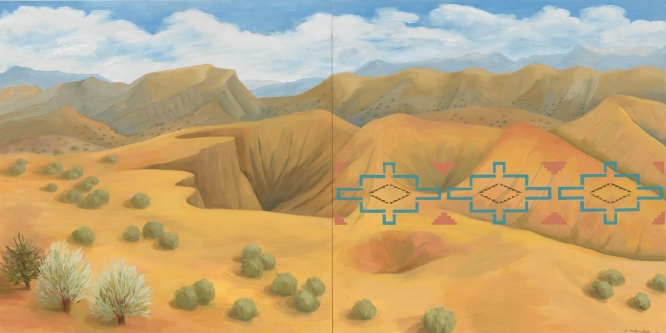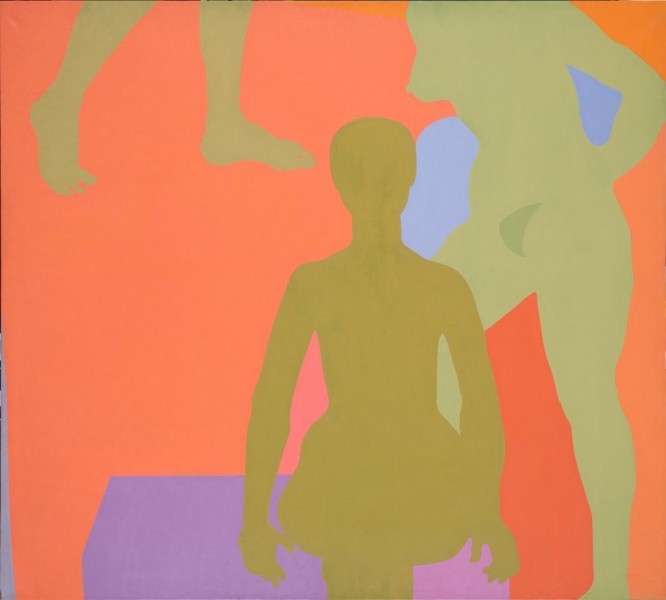 |
Canku Ota
|
 |
|
(Many Paths)
|
||
|
An Online Newsletter
Celebrating Native America
|
||
|
December 2015 - Volume
13 Number 12
|
||
|
|
||
|
National Museum Of
The American Indian Presents Unprecedented Retrospective
"Kay WalkingStick: An American Artist" |
||
|
by Press Release
|
||
|
Smithsonian Exhibition Highlights Multi-Dimensionality Of Celebrated Painter's Art For nearly five decades, Kay WalkingStick (Cherokee, b. 1935) has charted an artistic career that is not bound by singular definition. While her early work with Native themes celebrate heroic American Indian leaders with stately, abstract compositions and her more recent heroically scaled paintings recast American landscapes as Native places, WalkingStick's artistic persona originates from roots in the New York art world of the 1960s and 1970s and her immersion in considerations of abstraction, minimalism and feminist art. "Kay WalkingStick: An American Artist" is the first major retrospective of WalkingStick's work, including more than 75 works that trace her dynamic career from the 1970s to the present.
The exhibition will be on view from Nov. 7 through Sept. 18, 2016, in the National Museum of the American Indian's third-floor gallery. The American Federation of the Arts will tour the exhibition to the Dayton Art Institute in Dayton, Ohio (Feb. 9, 2017–May 7, 2017), Montclair Art Museum in Montclair, N.J. (Feb. 3, 2018–June 17, 2018) and two additional venues in 2017. "Kay WalkingStick: An American Artist" is co-curated by Kathleen Ash-Milby (Navajo), associate curator, and David Penney, associate director for museum scholarship. It features both well-known works, such as WalkingStick's "Chief Joseph" series and hallmark diptychs, as well as never-before-seen works, richly illustrated sketchbooks from the artist's personal collection and a gallery film featuring the artist discussing her work and process. A press preview will be held Monday, Nov. 2.
"For her entire career, Kay WalkingStick has been rewriting the narrative about Native peoples through her artwork, which has defied categorization," said Kevin Gover (Pawnee), director of the National Museum of the American Indian. "These seeming contradictions and complexity are part of being an American Indian today, and what makes her an American artist. Our nation itself is built upon diversity of culture and expression. WalkingStick's background and art reflect this same richness and diversity." The organization of the exhibition is chronological and features five major sections: "The Sensual Body," "Material and Meaning, "Two Views: Diptychs," "Italian Romance" and "Landscape: The Power of Native Place." WalkingStick's career progressed from an early focus on feminism and minimalism to spiritual explorations of landscapes through use of abstraction. Beginning in the 1980s, she began to more directly confront Native identity, both personal and within national histories, a practice that is still reflected in the artist's most recent paintings. After several semesters teaching and living in Italy spread over 17 years as a professor at Cornell University, the influence of Italian art and environment is also prevalent in many of her later works.
"Kay WalkingStick is arguably one of the most important American painters working today," said Penney. "But her resistance to a narrow program and insistence on defying categorization makes her enormous accomplishment less subject to summary and generalization." "Even avid followers of WalkingStick's work will be surprised at the depth and breadth of her art practice," said Ash-Milby. WalkingStick's biography is inextricably intertwined with her art. The exhibition examines key moments of her life, which further illuminate the artist's methods and motivations. Her entrance into the male-dominated New York art scene in the late 1960s and early 1970s, with her exhibition of vivid, playful explorations of the body, set the pace for a career of innovation and unique expression, breaking down barriers for both women and American Indian artists. Although her family moved from the Cherokee Nation to New York state before she was born, her exploration of Native history and her own identity is underscored in later evolutions of her work that focus on landscapes of the American West—a journey that continues to unfold.
Symposium Publication About the National Museum of the American Indian About the American Federation of the Arts
|
|||||||||
|
|
|
|
||
|
|
||
| Canku Ota is a free Newsletter celebrating Native America, its traditions and accomplishments . We do not provide subscriber or visitor names to anyone. Some articles presented in Canku Ota may contain copyright material. We have received appropriate permissions for republishing any articles. Material appearing here is distributed without profit or monetary gain to those who have expressed an interest. This is in accordance with Title 17 U.S.C. Section 107. | ||
|
Canku Ota is a copyright ©
2000 - 2015 of Vicki Williams Barry and Paul Barry.
|
||
 |
 |
|
|
The "Canku
Ota - A Newsletter Celebrating Native America" web site and
its design is the
|
||
|
Copyright ©
1999 - 2015 of Paul C. Barry.
|
||
|
All Rights Reserved.
|
||



